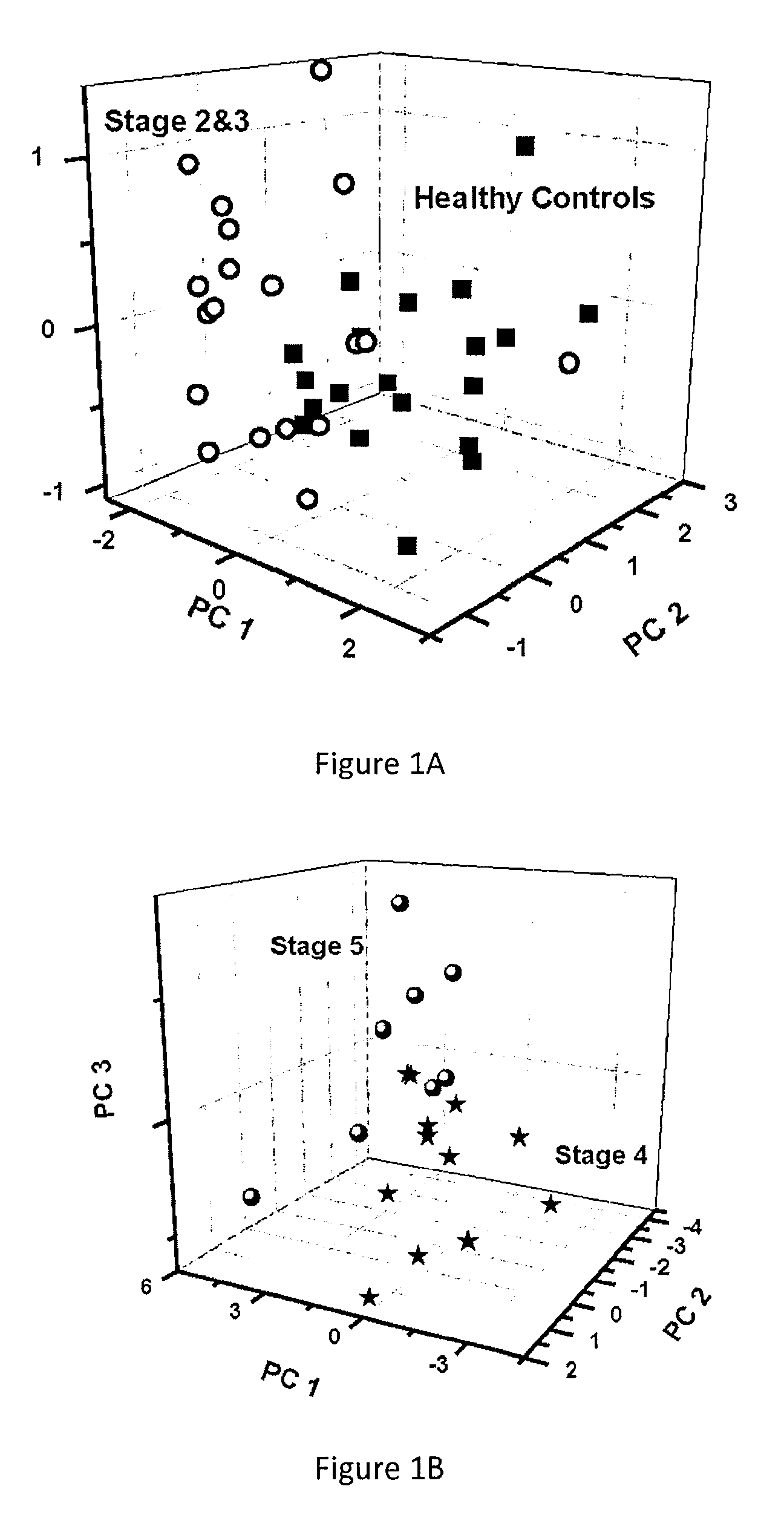Detection Of Chronic Kidney Disease And Disease Progression
a technology for chronic kidney disease and detection, applied in the field of detection of chronic kidney disease and disease progression, can solve the problems of delayed diagnosis and treatment of ckd, no simple and reliable technique, and up to 60% of kidney function may be los
- Summary
- Abstract
- Description
- Claims
- Application Information
AI Technical Summary
Benefits of technology
Problems solved by technology
Method used
Image
Examples
example 1
Test Population and Breath Collection
[0076]A cross-sectional comparative survey between patients attending the out-patient clinic at the Department of Nephrology, Rambam Health Care Campus (Haifa, Israel) and healthy controls (recruited from their accompanying persons) was performed. 62 volunteers at the ages of 22-83 having sufficient clinical and biochemical data were included as the test population (Table 1). The volunteers were recruited after written informed consent. The biochemical data was obtained from standard blood tests less than a month prior to breath testing. All subjects refrained from smoking and drinking coffee for 1 hour prior to breath sampling. The test population was categorized as follows: 22 patients with early (stages 2-3) CKD, 20 patients with advanced (stages 4-5) CKD and 20 healthy controls. The patients were under observation and were given medical treatment (converting enzyme inhibitors; angiotensin receptor blockers; calcium channel blockers; diuretics...
example 2
Breath Analysis Using the Sensor Array of the Present Invention
[0078]The breath samples were tested using the sensor array of the present invention. The array was composed of four cross-reactive chemiresistors that were based on four types of spherical monolayer coated gold nanoparticles (GNPs) with a core diameter of 3-4 nm (Tisch et al., Rev. Chem. Eng. 26, 171-179, 2011; WO 2010 / 079490, the content of each of which is hereby incorporated in its entirety). The organic ligands that were
[0079]used as coating: 2-ethylhexanethiol (sensor 1: S1), tert-dodecanethiol (sensor 2: S2), hexanethiol (sensor 3: S3), and dibutyl disulfide (sensor 4: S4). The GNPs were synthesized as described in Dovgolevsky at al., Small 4(11), 2059-2066, 2008; Dovgolevsky at al., Small 5(10), 1158-1161, 2009; Dovgolevsky at al., J. Phys. Chem. C 114(33), 14042-14049, 2010; and Tisch et al., MRS Bull. (35), 797-803, 2010, the content of each of which is hereby incorporated in its entirety.
[0080]GNP chemiresisti...
example 3
Breath Analysis Using Gas Chromatography Combined with Mass Spectrometry (GC-MS)
[0086]The constituent volatile compounds of the collected breath were identified from a representative sub-set of the collected breath samples (5 patients with stage 5 CKD; 10 patients with stage 4 CKD; 15 patients with stage 3 CKD; 5 patients with stage 2 CKD; and 7 healthy controls), using GC-MS (QP 2010 plus; Shimadzu). The GC-MS analysis was preceded by solid phase micro-extraction (SPME) for pre-concentrating the volatile compounds in the breath samples: A manual SPME holder with an extraction fiber was inserted into the Mylar bag for 30 min before being delivered to the GC-MS. Fibers with divinylbenzene / carboxen / polydimethylsiloxane coating were obtained from Sigma-Aldrich. The extracted fiber in the manual SPME holder was inserted into the injector of the GC (direct mode) for thermal desorption at 270° C. The GC oven profile is provided in Table 2. A capillary column RTX-624 6% cyanopropylphenyl (...
PUM
| Property | Measurement | Unit |
|---|---|---|
| diameters | aaaaa | aaaaa |
| sizes | aaaaa | aaaaa |
| size | aaaaa | aaaaa |
Abstract
Description
Claims
Application Information
 Login to View More
Login to View More - R&D
- Intellectual Property
- Life Sciences
- Materials
- Tech Scout
- Unparalleled Data Quality
- Higher Quality Content
- 60% Fewer Hallucinations
Browse by: Latest US Patents, China's latest patents, Technical Efficacy Thesaurus, Application Domain, Technology Topic, Popular Technical Reports.
© 2025 PatSnap. All rights reserved.Legal|Privacy policy|Modern Slavery Act Transparency Statement|Sitemap|About US| Contact US: help@patsnap.com



